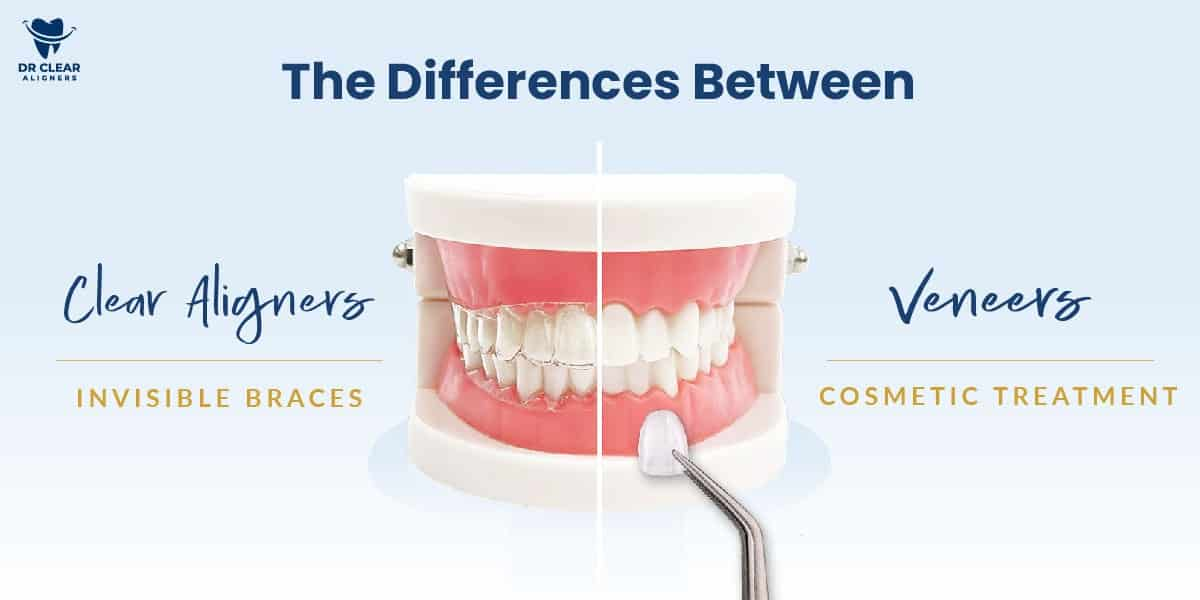What are Veneers and Aligners
So, what are veneers? Veneers are custom-designed restorations applied to the front surface of your teeth, providing a transformative change in shape and appearance, especially helpful if you have chipped or cracked teeth. These thin coverings are crafted to enhance your smile's aesthetics.Meanwhile, clear aligners, also known as invisible aligners, are a popular orthodontic option, providing discreet teeth straightening alternative to traditional metal braces. This trendy treatment procedure gradually changes tooth alignment without the visible presence of conventional braces.
In this comprehensive article, we delve deep into the world of cosmetic dentistry, guiding you through a detailed comparison of aligners and veneers. You'll gain insightful knowledge on:
• Veneers: Pros and Cons – Uncover the advantages and drawbacks of choosing veneers, helping you understand their impact on your dental health and aesthetics. • Aligners: Pros and Cons – Explore the benefits and limitations of aligners, and why they might be the right choice for your orthodontic needs. • Veneers vs. Aligners: Key Differences – Get a clear breakdown of how these two popular treatments differ in procedure, effectiveness, safety, cost, and suitability for various dental conditions.
Find out more about them below.
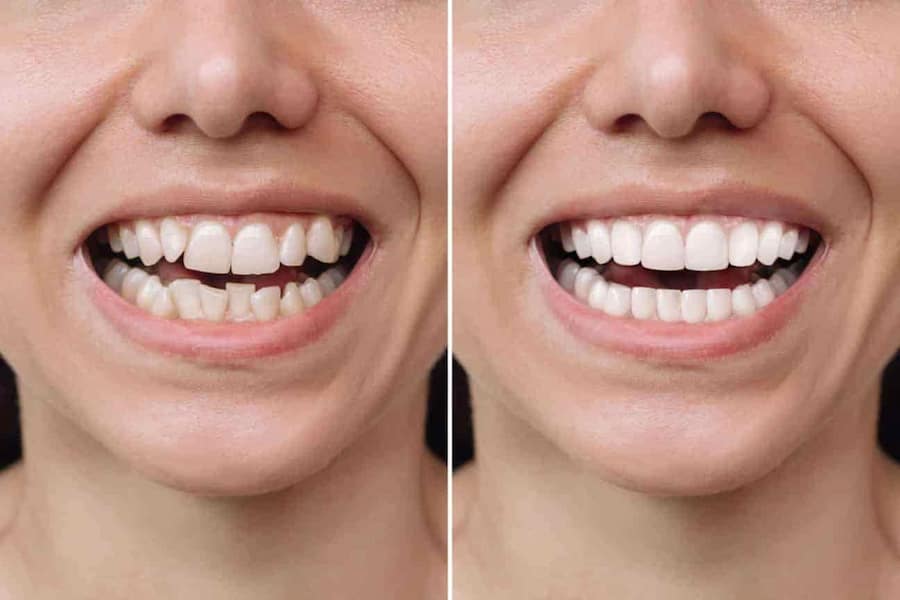
Before opting for veneers, it's crucial to carefully consider both the advantages and disadvantages to make an informed decision. Enhancing your smile is an exciting prospect, but understanding the aspects involved is essential.
Pros of Dental Veneers
Improved appearance
One of the most appealing features of veneers is that they will give you an immediate improvement in appearance. They are placed on your teeth, basically giving them a new look. This is particularly beneficial for addressing issues like chipped or spaced teeth.Instant results
Veneers offer the advantage of delivering instant results. Typically, it only takes up to three appointments to transform your smile into a new and improved version. This quick turnaround time can be especially appealing for those seeking prompt aesthetic changes.Stain resistance
Contrary to their delicate appearance, veneers exhibit remarkable resistance to staining. You can consume a wide range of foods and beverages without the constant concern of discolouring your teeth.Cons of Dental Veneers
Artificiality
It's worth noting that veneers may give off a somewhat artificial vibe. How noticeable this is largely depends on your dentist's expertise. Choosing a skilled professional is key here, as they can significantly reduce the artificial look and make your veneers appear more natural.Irreversible
One thing to keep in mind is that getting veneers is a permanent change. The process involves removing part of your tooth's surface, and once it's done, there's no going back. It's a decision you can't undo, so take your time to weigh the pros and cons.Prone to chipping and cracking
Be mindful of your eating habits after getting veneers. They're not unbreakable, especially when facing hard foods. To minimise the risk of damage, consider using your back molars for tougher bites and steer clear of biting directly with the front teeth. This precaution can go a long way in preserving the longevity of your veneers.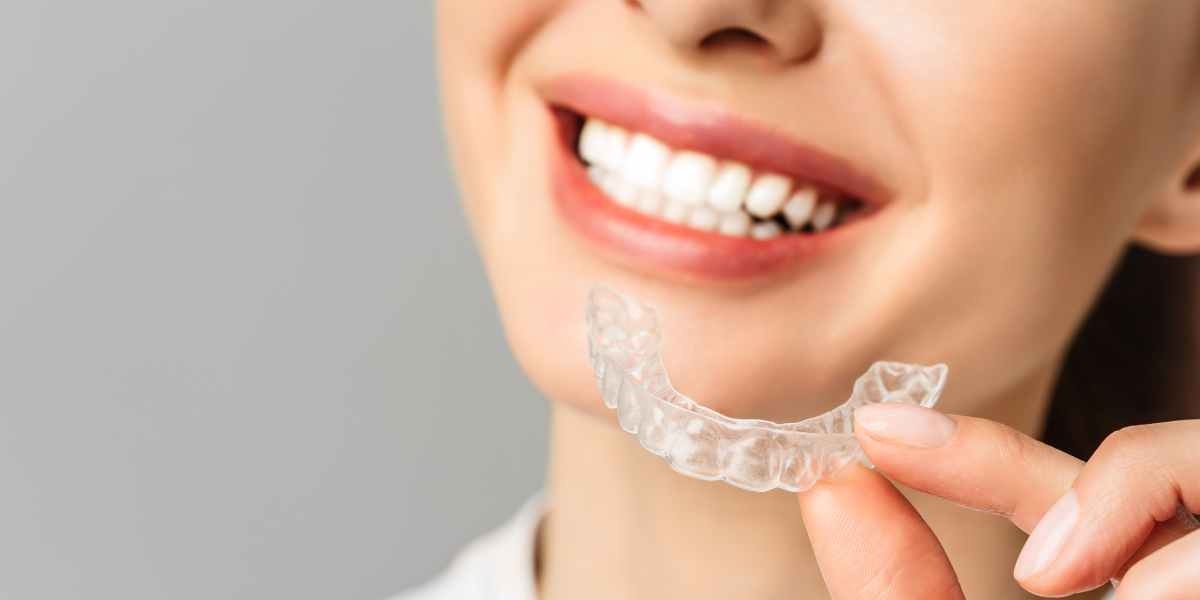
Now, let's delve into the advantages and disadvantages of clear aligners, providing you with valuable insights to aid in your decision-making process.
Pros of Invisible Aligners
Invisible
Clear aligners (or invisible braces) are well-known for their feature of being almost invisible. They are clear in appearance, giving you a more discreet braces treatment.Minimal dental appointments
Invisible braces treatment may require as few as one visit, depending on your specific case. After the visit, your progress can be monitored remotely, reducing the necessity for frequent in-person dental appointments during the aligner treatment.No dietary restrictions
Aligners are entirely removable, offering a wide range of food options. You can enjoy almost any type of food as long as you remove your aligners before eating.Cons of Invisible Aligners
Unable to treat complex teeth issue
Aligners are designed to address mild to moderate teeth bite issues. If you are dealing with severe malocclusion, likely, aligners may not be effective in resolving it. We recommend exploring alternative options that are better suited to treat your bite problems.22-hour wearing time
Wearing aligners necessitates a commitment of 20 to 22 hours per day, excluding the time spent on brushing, flossing, eating, and drinking. If full-time wearing commitment is challenging for you, aligners may not be the most suitable option.Initial discomforts
In the initial days of wearing aligners, discomfort may be experienced as they need to adjust to your teeth fully. Sensations of soreness and tightness are normal and typically subside within a few days. However, if the discomfort persists, it is advisable to consult with your orthodontist.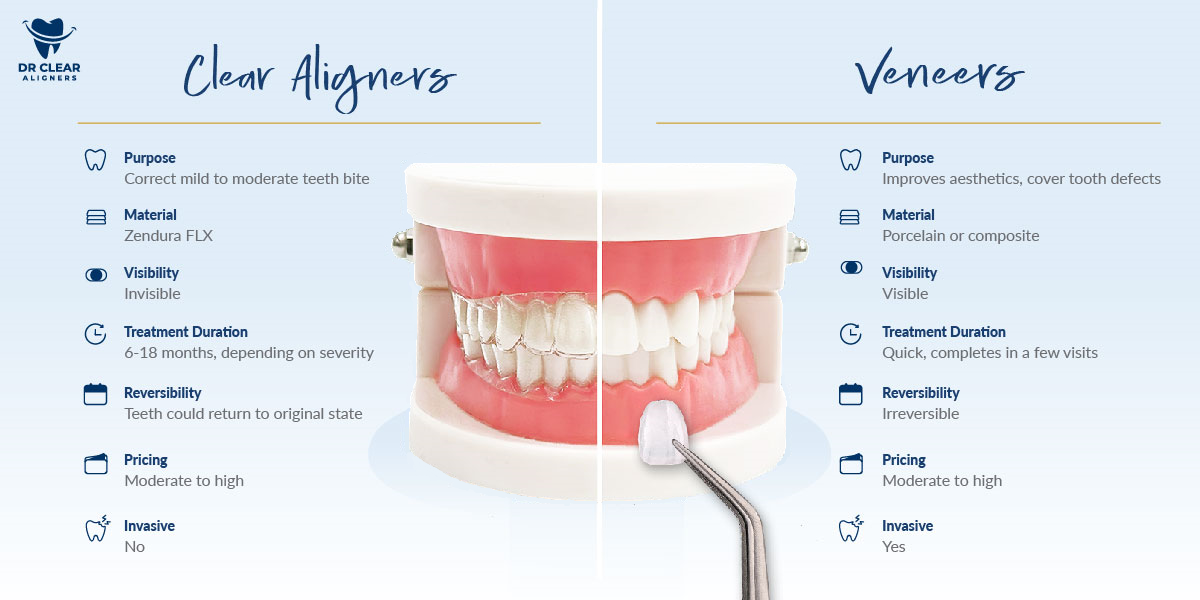
Which treatment costs less?
The pricing of veneers depends on several factors, including the chosen material—whether porcelain or ceramic—and the number of teeth being treated. Generally, the more teeth you choose to have veneers applied to, the higher the cost will be.The cost of clear aligners can start from RM5,500, typically spread over the treatment period, making it more affordable. Further details on aligner prices are also covered in our braces price article.
Which treatment is faster?
When considering treatment duration, veneers can be seen as the quicker option. However, it's crucial to weigh your overall goals and oral health before deciding which option suits you best, irrespective of the treatment length.Typically, the entire veneer procedure, from consultation to completion, takes around three weeks. This time frame encompasses the initial consultation, preparation of the teeth, crafting of the custom veneers in a dental laboratory, and the final bonding onto the teeth.
Clear aligners represent a form of orthodontic treatment designed to gradually straighten your teeth, enhancing both your smile and bite over time. The noticeable transformation typically occurs within 6-9 months.
Which treatment is safer?
Both are considered safe as they don’t usually involve invasive surgery. However, veneers do require that the surface of your teeth is permanently altered to allow the veneers to fit and bond correctly.While veneers are a cosmetic treatment and generally don't have a significant impact on your health, clear aligners are an orthodontic treatment that can benefit your oral health.
Which treatment has a longer-lasting result?
Porcelain veneers tend to last about 10 years. This assumes proper care of your veneers, though. By avoiding hard and crunchy foods and activities that could put them at risk of damage, like contact sports, you can help extend their lifespan.While aligners can change your smile for life, it also depends on the aftercare and your self-discipline. Do you follow the instructions of your orthodontists? Do you wear your retainers consistently every night before going to bed? The result varies in terms of the time and effort you put in.
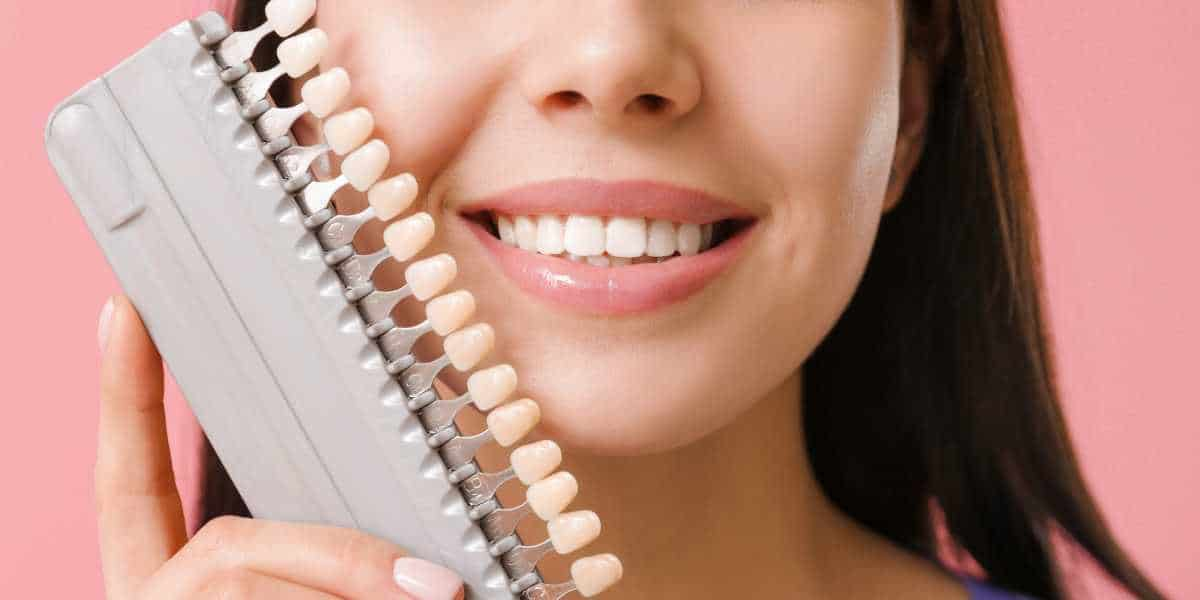
Which treatment can I get, and can I have both?
Consult your dentist and orthodontist on your concerns about these treatments. You will need to go through an oral health assessment before proceeding with the treatments required. Let’s say you have a condition such as tooth decay or gum disease, this will need to be treated before you begin another treatment.If you desire to have both veneers and clear aligners, it truly depends on how you want your smile to look, both treatments may be the right option for you. Typically, any orthodontic treatment will be completed first - this can reduce the number of veneers required and preserve more of your tooth structure. You may still be a candidate for clear aligners if you already have veneers since the aligners don't put as much pressure on your teeth as traditional metal braces.
Again, you should talk to a qualified dental professional and our experienced consultant who can examine your teeth and bite and recommend a treatment plan designated for you.
Comparing veneers and aligners might be tricky since they serve different purposes in cosmetic dentistry. The choice between them depends on the current state of your teeth and the specific treatment your dental health requires. It's essential to conduct a thorough assessment of your individual needs to determine the most fitting option for the best results. Don't miss out on a free smile consultation for additional insights on your dental concerns.
